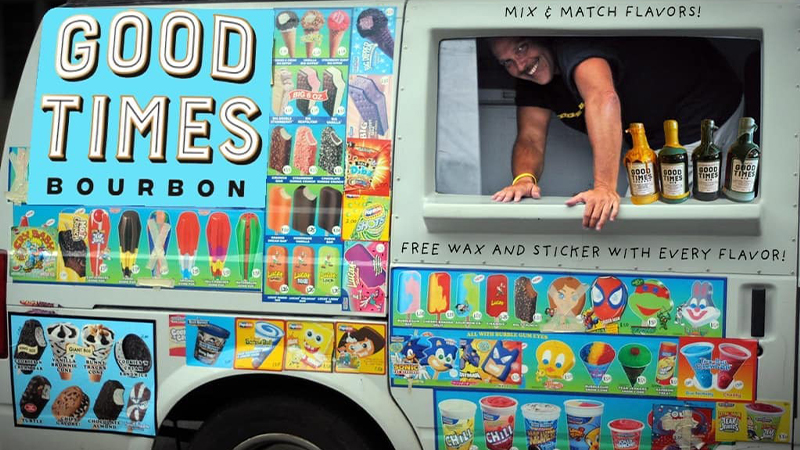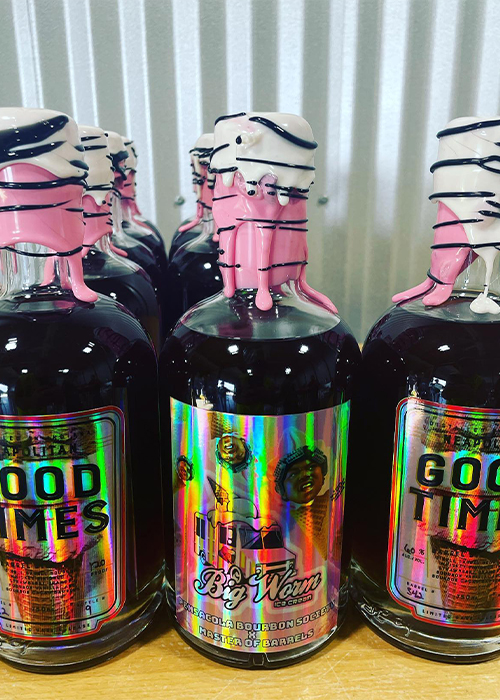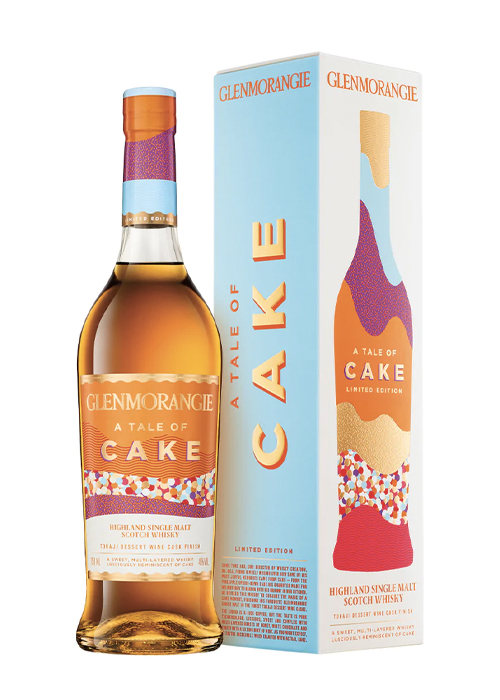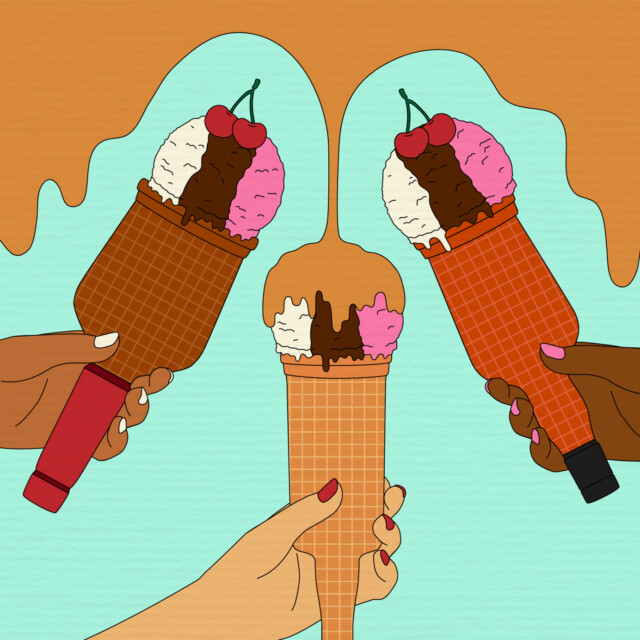In January of this year, satirical bourbon industry account @youwouldhateit posted an image of an ice cream truck photoshopped with a Good Times Bourbon logo over pictures of Bomb Pops, Drumsticks, and SpongeBob bars. The truck’s purveyor smiles from the ordering window, as wax-dipped bottles of some of Good Times’ most dessert-inspired whiskeys sit on the counter in front of him. “Mix & Match Flavors!” reads the truck’s sign. The anonymous Instagrammer behind the account was clearly trolling Good Times, but it provided inspiration instead.
“I think that meme is actually what led to our Neopolitan finish,” says Nick Ellingsworth, one of the owners of the upstart Kentucky brand, along with his childhood friend Jimmy Underwood.
A customer from the Pensacola Bourbon Society had come to the 120-acre Frankfort farm where the brand makes those very dessert-inspired single barrels that have wowed, shocked, grossed-out, been coveted by, and annoyed the industry, all in one fell swoop.
To create Neapolitan, sourced MGP rye was added to a bourbon barrel that had previously held liquid cacao. It was then dumped into a vanilla extract barrel, before finally finishing in a strawberry brandy barrel. If that’s not enough, its neck was dipped in both pink and white wax, then drizzled with a dark brown wax to simulate ice cream.

“This is ridiculous. So absurd. Send me three,” wrote one Instagram commenter, echoing the feelings of many drinkers now encountering this emerging trend of what I can only call pastry bourbons.
Are they delicious? Are they the beginning of the end of the industry? Does it matter? We look to craft beer for answers.
The Rise of Pastry
If the earliest example of bourbon barrel-aged beer was spawned in 1992 (or was it 1994?) by Goose Island with its Bourbon County Brand Stout, by the late-aughts, beer geeks couldn’t get enough of them, and soon high-ABV beers — mostly imperial stouts and barleywines — were being aged in any barrels breweries could find. Ex-bourbon, of course, but eventually port, Cognac, and rum casks too. (Sound familiar?)
By 2010, Goose Island had begun to add “adjuncts” (essentially extra ingredients) to its barrels of Bourbon County, notably with the release of Bourbon County Brand Coffee Stout and Bourbon County Brand Vanilla Stout, made by placing hand-scraped vanilla beans in the barrel. These were admittedly delicious, then highly coveted for beer geeks, and would quickly spawn an arms race.
I watched in the 2010s as desserts came to conquer craft beer — cocoa nibs, vanilla beans, spices, fruits, and, eventually, straight donuts, cookies, kids cereals, and candies dumped straight into the brew kettle or aging vessel. These were now beers that no longer tasted like beer — overly sweet and viscous, though smooth-tasting and high-ABV enough to get you pleasingly intoxicated. They were perfect for the neophyte palates taking over the industry — and I eventually grew to hate them.
By 2017, industry meme maestro Dontdrinkbeer had begun to pejoratively call these “pastry stouts,” a name that has stuck, and perhaps even been reclaimed by the industry’s most shameless practitioners.
Thankfully, the American whiskey industry has always fancied itself above this silliness, right?
Sure, there’s the cinnamon-flavored Fireball and the peanut butter booze Skrewball, both of which sell incredibly well. But those are for amateurs. College bar shooters. Even when Wild Turkey first released a honey liqueur in 1976, the company said it was intentionally designed “for the ladies,” not the supposedly experienced male bourbon drinker. (Though, today, Wild Turkey American Honey actually sells better with men.)
And yet, spearheaded by brands like Good Times, it seems like bourbon might be on the same path beer took a decade ago.
These Are the Good Times
Ellingsworth and Underwood grew up together in Mount Washington, Ky., just outside of Louisville. They worked jobs in corporate America and became bourbon collectors and admitted flippers of allocated releases. Their palates started to favor finished whiskeys, especially those from Bardstown Bourbon Company’s Collaborative series, like one matured in Château de Laubade Armagnac barrels.
Then Covid-19 hit and they decided to edge into the bourbon industry themselves. They sourced four barrels from MGP. Sold those. Bought eight more. Sold those. They went to cooperages and barrel brokers, trying to snag some empty apple brandy barrels, but instead they found a lot odder barrels available.
Peach brandy.
Texas wildflower honey.
Barrels that had formerly held caramel syrup.
They purchased them all and added them to their custom finishing availability sheet.
“A lot of these [releases] aren’t even our ideas,” admits Underwood. Barrel pickers from various whiskey clubs across America would see Good Times’ list of finishing barrels and start formulating their own wacky ideas. “We just want to provide the ultimate barrel pick experience. ‘Create your own bourbon!’”
They’ve done over 500 different finished single barrels in the last couple of years, and many lean toward a more dessert-y flavor profile like Neopolitan. There’s Toasted Cinnamon Honey, finished in toasted barrels along with bourbon barrels that previously aged honey and cinnamon. Vanilla Caramel is finished in bourbon barrels that once held vanilla extract and caramel syrup. Strawberry Kiwi is finished in barrels that held those aforementioned brandies.
Good Times claims to currently have about a half-million dollars worth of finishing barrels, everything from watermelon and pineapple brandy to coconut rum and maple syrup. They claim they receive them often without really knowing the provenance of where they originated — that’s just the barrel brokerage game.
Many bourbon groups and enthusiasts in the secondary market don’t seem to care, either. Whenever more interesting or provocative Good Times bottles are offered up online, they sell out quickly, and gray-market values hover in the $150 range. Quite high for what are mostly 5- and 6-year-old whiskeys.
There are plenty of haters too, of course. Especially on Reddit, where whenever a Good Times bottle is reviewed positively, an avalanche of critiques ensues.
“I find it funny that those same dudes will scoff at Knob Creek Smoked Maple or [Wild Turkey] American Honey, while sipping on a Toasted Strawberry Mocha Finished whiskey with a ‘Let’s Go Brandon’ sticker on it,” wrote one commenter on Reddit.
Indeed, Good Times “picks” often seem to favor the same sort of palates that are equally amused by affixing childish, IP-infringing, sometimes pornographic tater stickers to their bottles, yet another trend that mimics what has happened in craft beer over the last decade.
And, while so far the key difference between pastry stouts and these pastry bourbons is that actual adjuncts aren’t being added to the barrel, many have gone so far as to accuse Good Times of indeed doing that — illicitly adding flavorings.

“You really think a product like ‘Single Barrel Straight Rye Whiskey Finished in Strawberry Brandy and Kiwi Brandy Barrels’ exists?” says Jay West, a well-known online spirits reviewer. “They are straight-up flavoring whiskey under the pretense of the concoction entering a barrel first.”
It seems feasible. If you search the internet you will struggle to find a barrel-aged kiwi brandy having ever been released anywhere on planet Earth. And one reviewer of a Good Times release supposedly finished in chocolate and cherry brandy barrels mentioned there was enough liquid chocolate in the bottle that it settled to the bottom and had to be stirred up. (Alas, he gave it an overwhelmingly positive score of 9 out of 10.)
Underwood insists they are meticulous in making sure all the finishing barrels they receive are empty of the previous liquid; he claims they certainly don’t add any flavoring either, something that would not be allowed by the TTB without correct labeling.
“They hate us cause they ain’t us,” he says. “They’re traditionalists that haven’t even tried Good Times.”
This Section Is Intentionally Left Untitled
That’s not to say this path to pastrification is going to be paved with strictly over-the-top, if not childish gimmicks.
District Made Spirits in Washington, D.C., distills its own grain-to-glass whiskeys, gins, and vodka while using a separate brand — called Untitled — in which to experiment with sourced whiskeys and intriguing finishes. While many of these have been fairly standard — sherry casks for instance — one of its more popular ones is Untitled No. 12.
The distillery sent local chocolatier Harper Macaw some used bourbon barrels, which it then filled with cocoa nibs sourced from the Amazon. The bean-to-bar producer would age the nibs for six months before turning them into Bourbon Barrel Aged Chocolate; while District Made Spirits would take the barrels back and fill them with a 7-year-old wheated bourbon, which it then aged for another couple of years.
“It has an amazing cocoa flavor” says Alex Laufer, co-founder and head distiller at District Made Spirits. Though, it’s not like it’s a saccharine-sweet combination of whiskey and Hershey’s syrup by any means. Instead there’s a nice interplay between the dark fruits, coffee notes, and earthy, bitter chocolate of the cocoa nibs and the caramels, vanilla, and baking spices of the bourbon. “The key with anything is to not lose the character of the bourbon. Chocolate is a strong flavor, but I think it makes such a winning combination with bourbon that it’s worth using it,” Laufer says.
Others aren’t so sure, however.
“The sort of product that were it made in Scotland would have the SWA [Scotch Whisky Association] up in arms and like cause some level of furore [sic],” wrote blogger Matt McKay of The Dramble after sampling Untitled No. 12, though he begrudgingly admired the ambition.
And, he’s not quite correct, either. Because in supposedly stuffy Scotland, pastry has already come. Or, at least, cake has.
“Like so many of us, some of my favorite memories come from cake, whether it be helping my granny in her kitchen, or the pineapple birthday cake my daughter surprised me with one year,” claimed Dr. Bill Lumsden of Glenmorangie upon the release of his single malt distillery’s A Tale of Cake in late 2020. He created it by finishing Glenmorangie in Tokaji dessert wine casks. The label appeared to look like cake, complete with frosting and sprinkles. Glenmorangie even teamed up with Cronut maven Dominique Ansel to develop a series of paired “CakeTails” — essentially booze-steeped cakes.
For a brand long known for innovation and ambitious wood management, though, A Tale of Cake was one of my least favorite Glenmorangie releases ever.
Pastry or Junk Food?
“I see the whole trend as a leading indicator that we’re entering the death spiral of the whiskey boom,” says @youwouldhateit. “When the masses run out of novelties they’ll move on as they always do.”

But, I’m not so sure.
Older, more “serious” drinkers like myself may have (mostly) moved on from the craft beer world as pastry stout, fruited kettle sours, and juicy IPAs came to dominate the scene. But many people who didn’t actually like “beer that tastes like beer” welcomed those trends with open arms.
Who cares about serious drinkers, anyway? Good Times is literally named that because Ellingsworth and Underwood consider themselves party animals who don’t think the industry should be so serious.
“A lot of people just getting into bourbon don’t like barrel-strength whiskey,” says Underwood. “But they like [Good Times]. It can help expand their palate.”
The same seems to be true at District Made Spirits, which recently released Untitled No. 19, an 11-year bourbon finished in a variety of casks, though, most prominently, kirschwasser cherry brandy. Even Laufer isn’t so sure he fully loved this one, which has the intense notes of dark cherries.
“There’s so much fruit, it will turn some bourbon purists off,” he admits, also noting that while these more dessert-y selections don’t score great in whiskey competitions, they are great for bringing drinkers into the fray who aren’t typically bourbon enthusiasts. “You do see some of the folks who are not sure they love bourbon. So we can convince them with other flavors perhaps.
“And it’s not like we’re making Skrewball or Fireball.”
As for @youwouldhateit, they do think these brands are essentially making those flavored liqueurs and it will ultimately end the great run the bourbon industry has been on for the last two decades-plus. The way they see it, instead of new craft distilleries emerging and putting their own stamp on the industry through the natural variance found in regional grains, local climates, and wood programs, they’re forced to tantalize with gimmicks.
“A toasted cinnamon pineapple maple syrup finish doesn’t teach anyone anything about whiskey,” they say. “It doesn’t broaden any horizons. There’s no growth there.
“It’s just junk food.”
